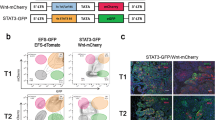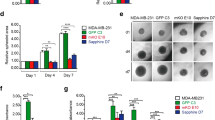Abstract
We have examined the effects of the microenvironment on the frequency and generation of metastatic variant cells in both parental B16F1 melanoma cells and nascent clones. The metastatic abilities of cultured B16F1 cells were tested after a period of growth in the presence or absence of a second cell population separated from each other by a transwell membrane (0.45μm pore size). The first population is defined as the ‘responder’ cells and the second as the ‘stimulator’ cells. We found that the presence of 105 B16F1 stimulator cells during the growth of responder B16F1 cells from ∼104 to ∼106 cells resulted in cells with an increased metastatic phenotype (> 8-fold increase in median number of lung tumors relative to untreated B16F1 parental cells). The presence of stimulator cells also increased the metastatic phenotype of nascent clones, which were grown to a population size of <106 cells, suggesting that the rate of generation of metastatic variants of the responder B16F1 clones was affected by the stimulator cells. Other cell lines, including highly metastatic B16F10 and BL6 melanoma cells, and KHT35-L1 fibrosarcoma cells, were effective stimulator cells when as few as 104 cells were added to transwells. In addition, normal immortalized NIH 3T3 cells were effective stimulator cells only at 105 cells/transwell. The cell density at which untreated parental B16F1 cells were harvested (3×103−3 × 105 cells/cm2) did not affect the median number of lung tumors significantly. These results suggest that factors released from both tumor and immortalized normal cells can modulate epigenetic changes in the metastatic phenotype of B16F1 melanoma cells.
Similar content being viewed by others
References
Aubert, C., Rouge, F., andVoulot, C., 1990, New variants of the B16 melanoma: tumorigenicity and metastatic properties under different culture conditions.Journal of the National Cancer Institute,82, 952–958.
Bosmann, H. B., andLione, A., 1974, Capacity for tumor cell implantation as a function ofin vitro cell density.Biochemical and Biophysical Research Communications,61, 564–567.
Bennett, D. C., Dexter, T. J., Ormerod, E. J., andHart, I. R., 1986, Increased experimental metastatic capacity of a murine melanoma following induction of differentiation.Cancer Research,46, 3239–3244.
Chambers, A. F., Harris, J. F., Ling, V., andHill, R. P., 1984, Rapid phenotype variation in cells derived from lung metastases of KHT fibrosarcoma.Invasion and Metastasis,4, 225–237.
Damen, J. E., Tagger, A. Y., Greenberg, A. H., andWright, J. A., 1989, Generation of metastatic variants in populations of mutator and amplificator mutants.Journal of the National Cancer Institute,81, 628–631.
Fidler, I. J., 1973, Selection of successive tumour lines for metastasis.Nature,242, 148–149.
Fidler, I. J., 1975, Biological behavior of malignant melanoma cells correlated to their survivalin vivo.Cancer Research,35, 218–224.
Harris, J. F., Chambers, A. F., Hill, R. P., andLing, V., 1982, Metastatic variants are generated spontaneously at a high rate in mouse KHT tumor.Proceedings of the National Academy of Sciences, USA,79, 5547–5551.
Harris, J. F., Chambers, A. F., Ling, V., andHill, R. P., 1987, Dynamic heterogeneity: Characterization of two cell lines derived from experimental lung metastases of mouse KHT fibrosarcoma.Invasion and Metastasis,7, 217–229.
Harris, J. F., andBest, M. W., 1988, Dynamic heterogeneity: metastatic variants to liver are generated spontaneously in mouse embryonal carcinoma cells.Clinical and Experimental Metastasis,6, 451–462.
Hart, I. R., 1979, The selection and characterization of an invasive variant of the B16 melanoma.American Journal of Pathology,97, 587–600.
Heppner, G. H., 1984, Tumor heterogeneity.Cancer Research,44, 2259–2265.
Hill, R. P., Chambers, A. F., Ling, V., andHarris, J. F., 1984, Dynamic heterogeneity: rapid generation of metastatic variants in mouse B16 melanoma cells.Science,224, 998–1001.
Kameyama, K., Vieira, W. D., Tsukamoto, K., Law, L. W., andHearing, V.J., 1990, Differentiation and the tumorigenic and metastatic phenotype of murine melanoma cells.International Journal of Cancer,45, 1151–1158.
Kendal, W. S., Wang, R.-Y., andFrost, P., 1987, Spontaneous mutation rates in cloned murine tumors do not correlate with metastatic potential, whereas the prevalence of karyotypic abnormalities in the parental tumors does.International Journal of Cancer,40, 408–413.
Korycka, B. M., andHill, R. P., 1989, Dynamic heterogeneity: experimental metastasis studies with RIF-1 fibrosarcoma.Clinical and Experimental Metastasis,7, 107–116.
Ling, V., Chambers, A. F., Harris, J. F., andHill, R. P., 1985, Quantitative genetic analysis of tumor progression.Cancer and Metastasis Reviews,4, 173–194.
Miner, K. M., Kawaguchi, T., Uba, G. W., andNicolson, G. L., 1982, Clonal drift of cell surface, melanogenic and experimental metastatic properties of anin vivo two-selected brain colonizing murine B16 melanoma.Cancer Research,42, 4631–4638.
Nicolson, G. L., andDulski, K. M., 1986, Organ specificity of metastatic tumor colonization is related to organ-selective growth properties of malignant cells.International Journal of Cancer,38, 289–294.
Nicolson, G. L., 1987, Tumor cell instability, diversification, and progression to the metastatic phenotype: from oncogene to oncofetal expression.Cancer Research,47, 1473–1487.
Nowell, P. C., 1986, Mechanisms of tumor progression.Cancer Research,46, 2203–2207.
Pantazis, C. G., andCheetham, J., 1985, Teratocarcinoma cells cultured on embryonic substrates show accelerated migrating behaviorin vitro and increased metastatic activityin vivo.Proceedings of the Society for Experimental Biology and Medicine (New York),180, 203–208.
Pohl, J., Radler-Pohl, A., andSchirrmacher, V., 1988, A model to account for the effects of oncogenes, TPA, and retinoic acid on the regulation of genes involved in metastasis.Cancer and Metastasis Reviews,7, 347–356.
Poste, G., Doll, J., andFidler, I. J., 1981, Interactions among clonal subpopulations affect stability of the metastatic phenotype in polyclonal populations of B16 melanoma cells.Proceedings of the National Academy of Sciences, USA,78, 6226–6230.
Price, J. E., Tarin, D., andFidler, I. J., 1988, Influence of organ microenvironment on pigmentation of a metastatic murine melanoma.Cancer Research,48, 2258–2264.
Price, J. E., Naito, S., andFidler, I. J., 1988, Growth in an organ microenvironment as a selective process in metastasis.Clinical and Experimental Metastasis,6, 91–102.
Ramshaw, I. A., Badenoch-Jones, P., Grant, A., Maxted, M., andClaudianos, C., 1986, Enhanced plasminogen activator production by highly metastatic variant cell lines of a rat mammary adenocarcinoma.Invasion and Metastasis,6, 133–144.
Russell, W. C., Newman, C., andWilliamson, D. H., 1975, A simple cytochemical technique for demonstration of DNA in cells infected with mycoplasms and viruses.Nature,253, 461–462.
Sargent, N. S. E., Oestreicher, M., Haidvogl, H., Madnick, H. M., andBurger, M. M., 1988, Growth regulation of cancer metastases by their host organ.Proceedings of the National Academy of Sciences, USA,85, 7251–7255.
Terranova, V. P., Williams, J. E., Liotta, L. A., andMartin, G. R., 1984, Modulation of the metastatic activity of melanoma cells by laminin and fibronectin.Science,23, 982–985.
Young, S. D., andHill, R. P., 1986, Dynamic heterogeneity: isolation of murine tumor cell populations enriched for metastatic variants and quantification of the unstable expression of the phenotype.Clinical and Experimental Metastasis,4, 153–176.
Weiss, L., 1990, Metastatic inefficiency.Advances in Cancer Research,54, 159–211.
Author information
Authors and Affiliations
Rights and permissions
About this article
Cite this article
Harris, J.F., Chambers, A.F. & Tam, A.S.K. Modulation of clonal progression in B16F1 melanoma cells. Clin Exp Metast 9, 151–162 (1991). https://doi.org/10.1007/BF01756386
Received:
Accepted:
Issue Date:
DOI: https://doi.org/10.1007/BF01756386




